1. Introduction
Southwestern Mexico, especially in and around the state of Nayarit (Figure 1), is a highly prospective region for epithermal deposits (Aguilar-Nogales, 1987a,b; Camprubí et al., 2003; Camprubí and Albinson, 2006, 2007; Camprubí, 2013), either Au-Ag or polymetallic deposits, which are likely to correspond to dominantly low or intermediate sulfidation deposits, respectively. The Cinco Minas district is located in the north-central part of the state of Jalisco (Figure 1), and contains Au-Ag low sufidation epithermal vein deposits albeit little significant geological or economical information is available for ore deposits in this region (e.g., Aguilar-Nogales, 1987a,b; Consejo de Recursos Minerales, 1992; Servicio Geológico Mexicano, 2006a,b). The epithermal veins of the Cinco Minas district occur in the vicinities of the regional-scale Cinco Minas normal fault (Servicio Geológico Mexicano, 2006a,b). This fault was considered to be latest Miocene to early Pliocene in age by Ferrari and Rosas-Elguera (2000), and found in the northwestern part of the Plan de Barrancas-Santa Rosa graben, the latter being a part of the Tepic-Zacoalco rift. The epithermal veins are hosted by early Miocene ignimbrites and andesites of the Sierra Madre Occidental, that were dated by means of K-Ar, thus yielding ages at 24.7 ± 0.6, 22.5 ± 0.4, and 20.2 ± 0.5 Ma (Nieto-Obregón et al., 1985). These rocks were intruded by a granodioritic body, which is well exposed in the Santo Domingo village and was dated at 19.5 ± 0.5 Ma (Nieto-Obregón et al., 1985). These ages are consistent with the Miocene metallogenic episode in the southern portion of the Sierra Madre Occidental silicic large igneous province (SLIP) in association with its last ignimbrite flare-up (Camprubí et al., 2003; Ferrari et al., 2005, 2007; Camprubí and Albinson, 2006, 2007; Camprubí, 2013, and references therein). Camprubí et al.(2003) interpreted that epithermal deposits in the Cinco Minas area would be related to the intrusive at Santo Domingo, which would therefore confer to these deposits ages younger than 19.5 Ma.
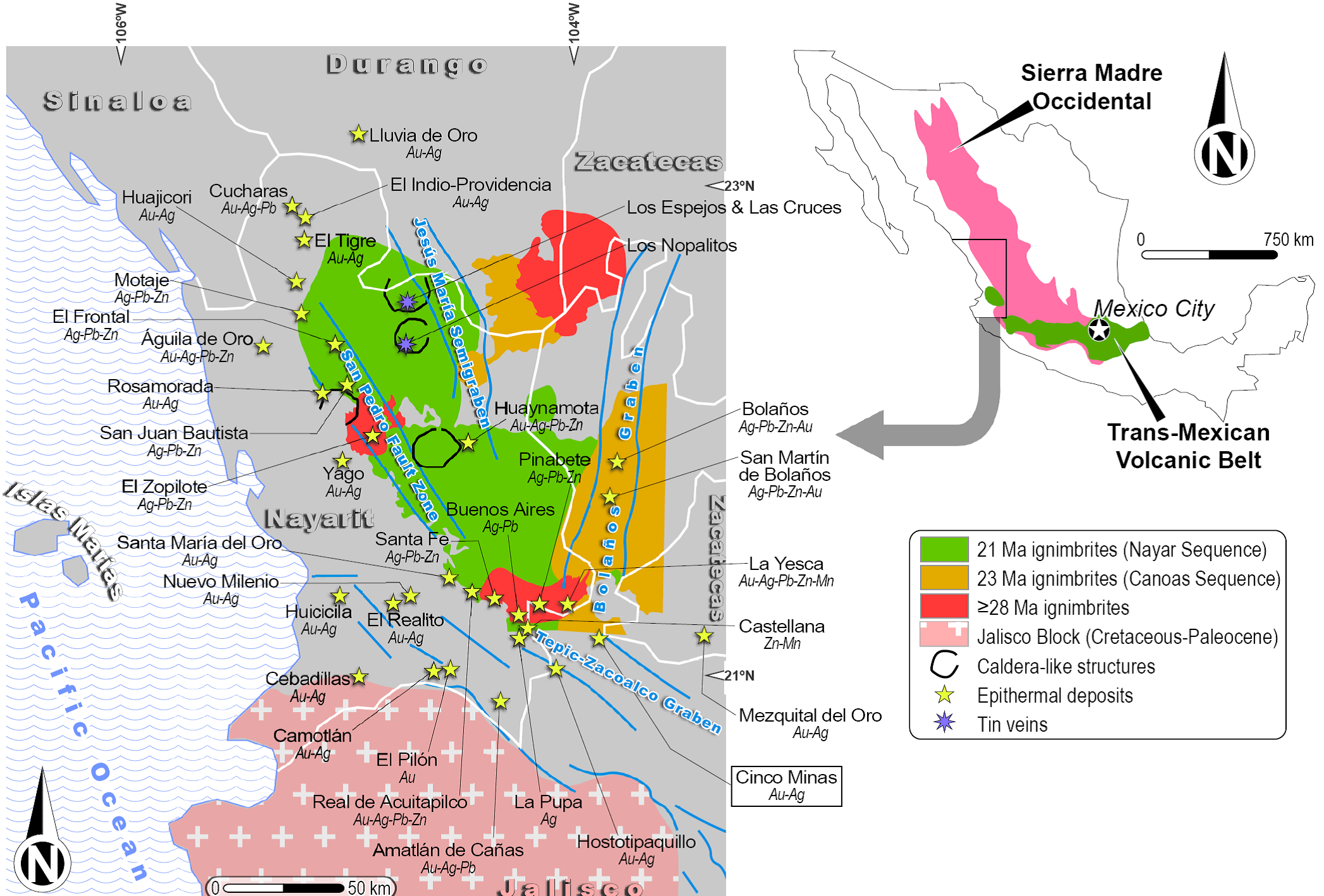
Figure 1 Geographic distribution of ore deposits of possible latest Oligocene to Miocene age in southwestern Mexico (modified from Camprubí, 2013).
Miocene ages were deduced (Camprubí et al., 2003) for several epithermal deposits, and a few tin vein deposits associated with fluorine-rich rhyolites, in the region shown in Figure 1. However, the vast majority of these deposits remain undated; that, notwithstanding that these deposits constitute the last mineralized area and metallogenic epoch associated with the evolution of the Sierra Madre Occidental SLIP (Camprubí, 2013). Such was the case of the epithermal deposits at Cinco Minas, for which we present the first age determinations in this paper.
2. Methods and results
Pure mineral separates of adularia from crustiform vein material (mostly quartz; Figure 2) from the Cinco Minas district were dated by 40Ar/39Ar geochronology (Figures 3 and 4, and Tables 1 and 2). Adularia grains that ranged in size from 250 to 180 μm were obtained by crushing and were separated using heavy liquids and hand picking to a purity of > 99 %. The samples were washed in acetone, alcohol, and deionized water in an ultrasonic cleaner to remove dust and then re-sieved by hand using a 180-μm sieve. Aliquots of these samples were analyzed in two separate laboratories.
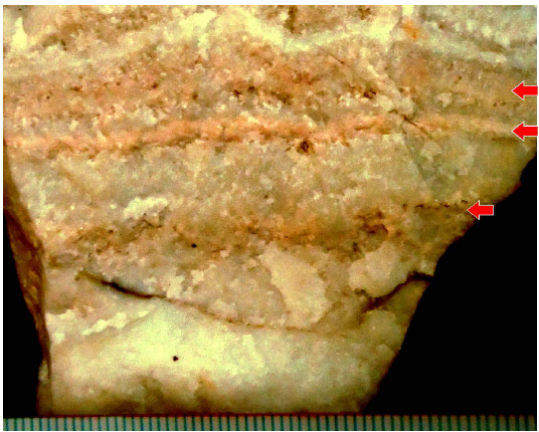
Figure 2 Alternated crustiform silica and adularia bands (the latter, rose bands indicated by red arrows) of low sulfidation epithermal veins of the Cinco Minas district. Adularia from the middle band corresponds to sample 5M-1.
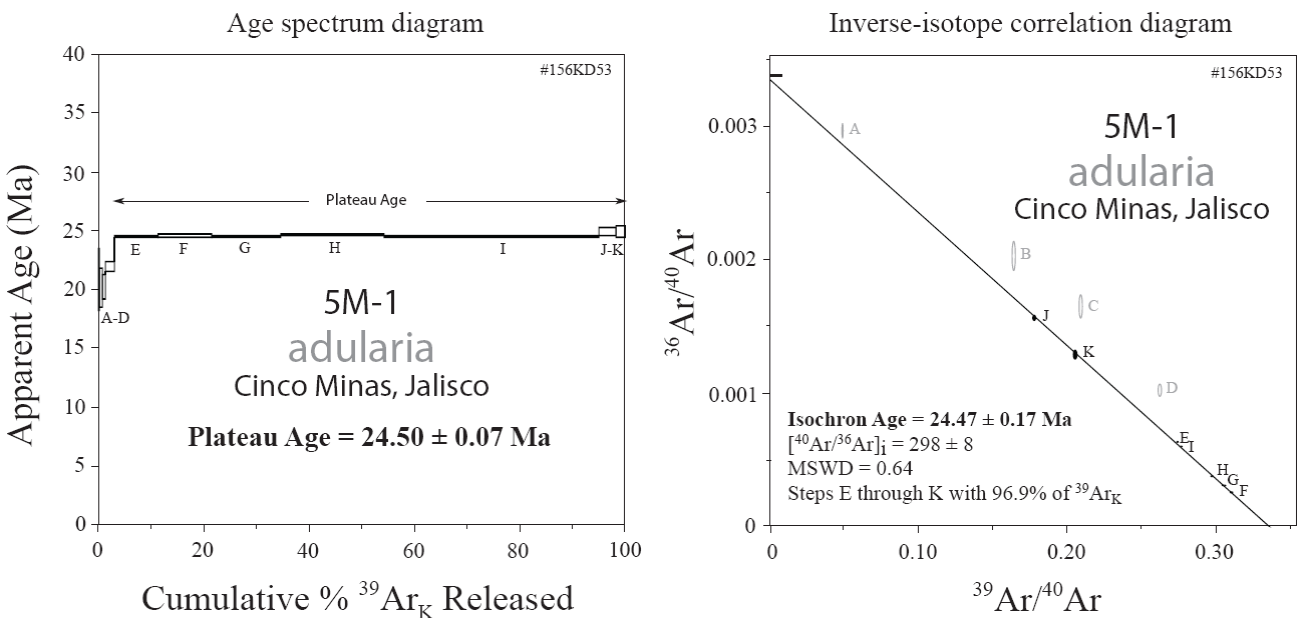
Figure 3 40Ar/39Ar age spectrum and isochron for the 5M-1 adularia sample from low sulfidation epithermal veins of the Cinco Minas district (USGS laboratory).
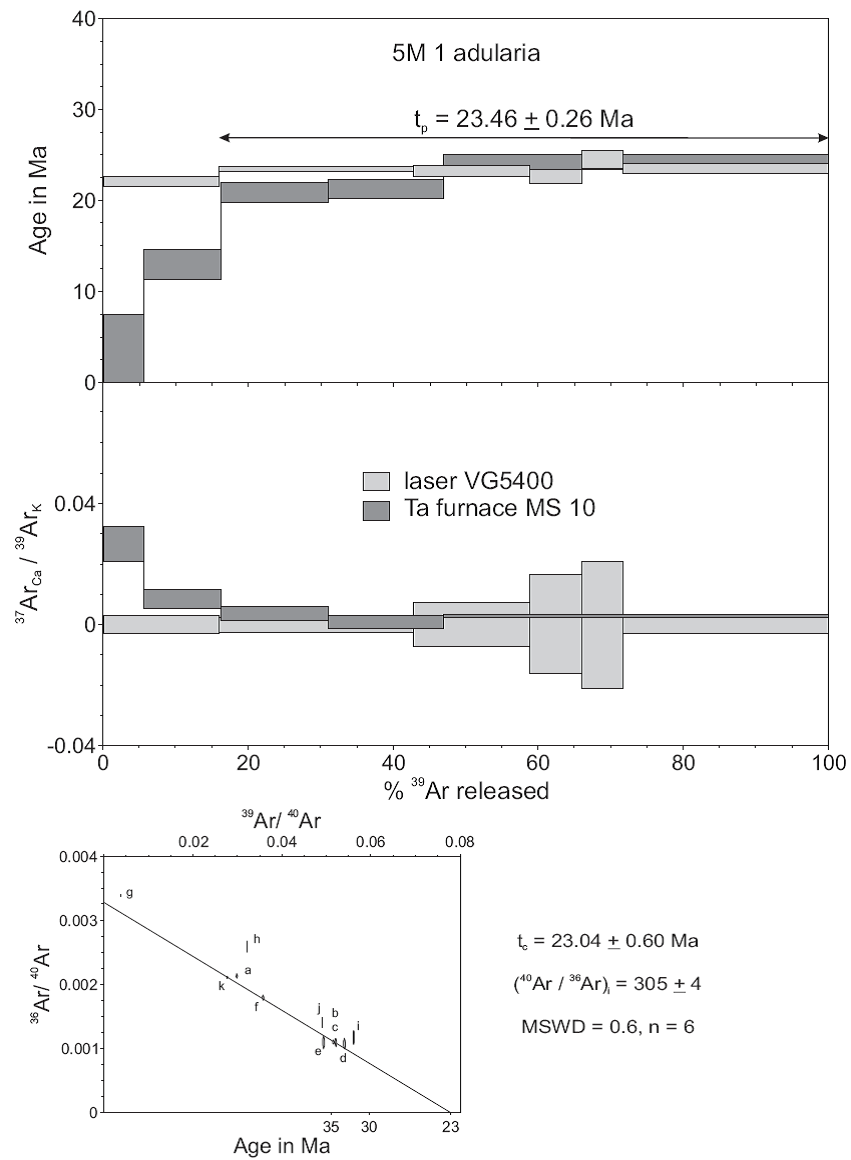
Figure 4 40Ar/39Ar age spectrum and isochron for the 5M-1 adularia sample from low sulfidation epithermal veins of the Cinco Minas district (USGS laboratory).
Table 1 40Ar/39Ar step-heating data for an adularia sample of the epithermal veins at the Cinco Minas district, Jalisco (USGS lab).
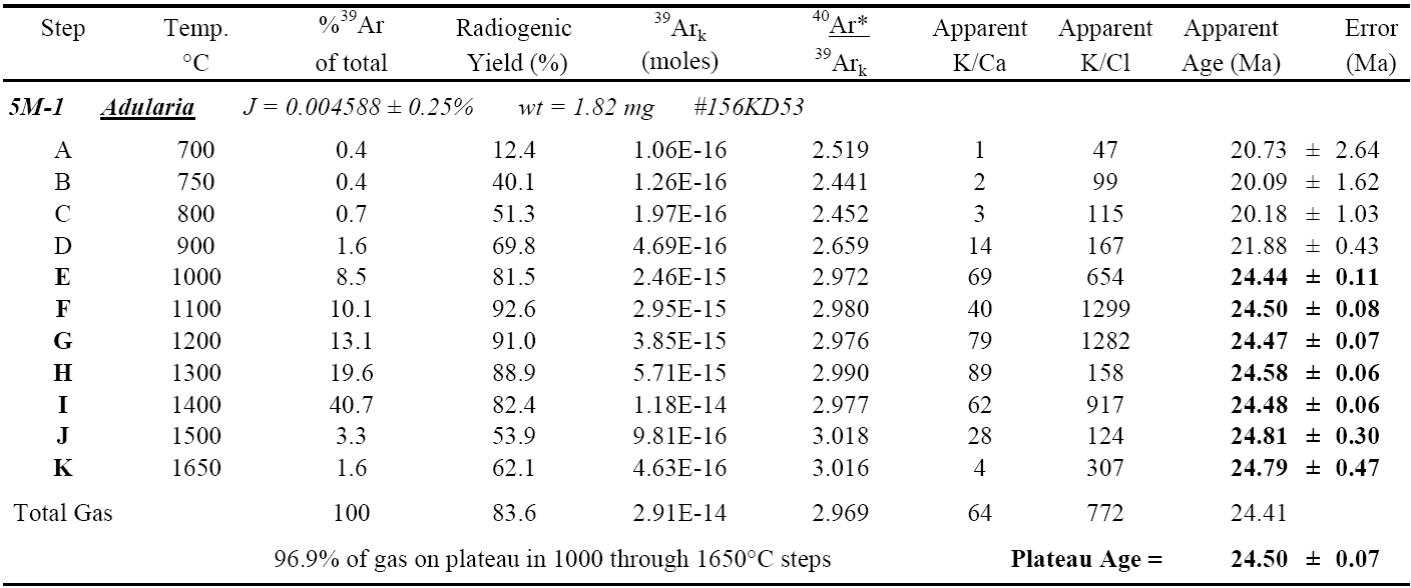
Ages calculated assuming an initial 40Ar/36Ar = 295.5 ± 0.
All precision estimates are at the one sigma level of precision.
Ages of individual steps do not include error in the irradiation parameter J.
No error is calculated for the total gas age.
Table 2 40Ar/39Ar step-heating data for an adularia sample of the epithermal veins at the Cinco Minas district, Jalisco (CICESE lab).
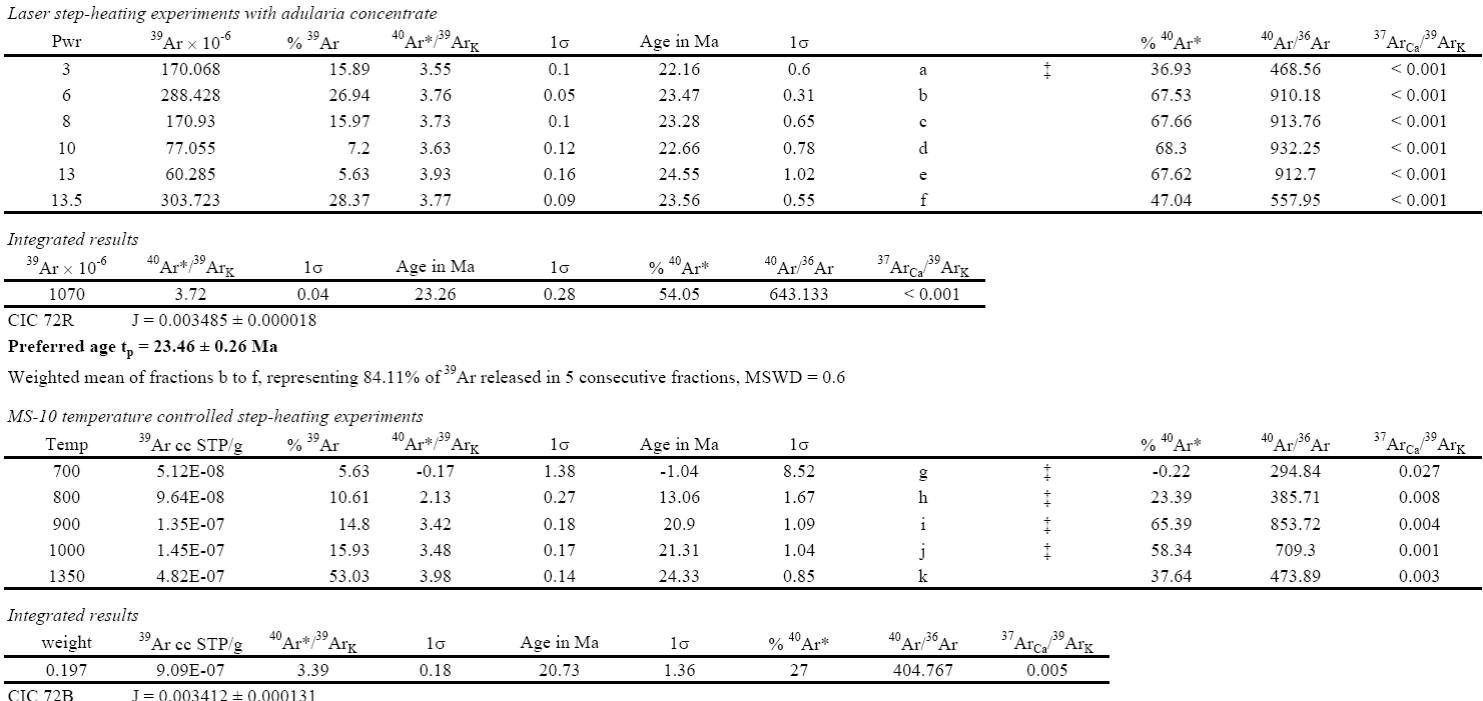
tc = 23.04 ± 0.60 Ma; (40Ar/36Ar)i = 305 ± 4, MSWD = 0.6 for n = 6
‡ fraction ignored in the isochron given in the figure
2.1. Procedure and results in laboratory 1
Aliquots of the adularia sample 5M-1 (1.82 mg) were packaged in copper capsules and sealed under vacuum in quartz tubes. The sample aliquots were then irradiated in package number KD53 for 20 hours in the central thimble facility at the TRIGA reactor (GSTR) at the U.S. Geological Survey in Denver, Colorado. The monitor mineral used in the package was Fish Canyon Tuff sanidine (FCT-3) with an age of 27.79 Ma (Kunk et al., 1985; Cebula et al., 1986) relative to MMhb-1 with an age of 519.4 ± 2.5 Ma (Alexander et al., 1978; Dalrymple et al., 1981). The type of container and the geometry of the sample and standards were similar to that described by Snee et al. (1988).
The adularia sample was analyzed at the U.S. Geological Survey Thermochronology lab in Denver, Colorado, using the 40Ar/39Ar step-heating method and a MAP 216 mass spectrometer fitted with an electron multiplier. For additional information on the analytical procedure see Kunk et al. (2001).
The 40Ar/39Ar results are listed in Table 1 and presented in Figure 3. The analyzed sample yielded a plateau age at 24.50 ± 0.07 Ma, which is supported, within analytical error, by the less precise isochron age calculated at 24.47 ± 0.17 Ma.
2.2. Procedure and results in laboratory 2
The 40Ar/39Ar analyses were performed at the Geochronology Laboratory of the Departmento de Geología, Centro de Investigación Científica y Educación Superior de Ensenada (CICESE, Mexico). The argon isotope experiments were conducted on fragments separated from sample 5M-1. The mineral grains were heated, in two different experiments, with a MS-10 Ta furnace and with a Coherent Ar-ion Innova 370 laser. The extraction system is on line with a VG5400 mass spectrometer. The sample and irradiation monitors, were irradiated in the U-enriched research reactor of University of McMaster in Hamilton, Canada, at position 5C. To block thermal neutrons, the capsule was covered with a cadmium liner during irradiation. To determine the neutron flux variations, aliquots of the irradiation monitor FCT sanidine (28.201 ± 0.046 Ma; Kuiper et al., 2008) were irradiated alongside sample 5M-1. Upon irradiation the monitors were fused in one step while the adularia sample 5M-1 was step-heated. The argon isotopes were corrected for blank, mass discrimination, radioactive decay of 37Ar and 39Ar and atmospheric contamination. For the Ca neutron interference reactions, the factors given by Masliwec (1984) were used. The decay constants recommended by Steiger and Jäger (1977) were applied in the data processing. The equations reported by York et al. (2004) were used in all the straight line fitting routines of the argon data reduction. The relevant 40Ar/39Ar data are presented in Table 2, which includes the results of the individual steps, and the integrated, plateau and isochron ages. The analytical precision is reported as one standard deviation (1σ). The error in the integrated, plateau and isochron ages includes the scatter in the irradiation monitors.
The 40Ar/39Ar results are listed in Table 2 and presented in Figure 4. The analyzed sample yielded a plateau age at 23.46 ± 0.26 Ma.
3. Discussion and conclusions
There is a slight discrepancy in the 40Ar/39Ar ages from laboratories 1 and 2: 24.50 ± 0.07 vs. 23.46 ± 0.26 Ma, respectively (both corresponding to the latest Oligocene). This can be explained by the different temperature ranges used in the experiments: those using a MS-10 Ta furnace in laboratory 2 (CICESE) attained 1350 °C, whereas those in laboratory 1 (USGS) attained 1600 °C, and there was no sound temperature control on laser experiments in laboratory 2. In addition, the amount of 39Ar released behaved differently in these experiments: ~ 40 % was released at 1400 °C in laboratory 1 (USGS), whereas ~ 53 % was released at 1350 °C using the Ta furnace in laboratory 2 (CICESE). In addition, such different behavior may be attributed to having used different reactors and conditions for irradiation. All the same, both can be essentially considered as the same age.
The ages obtained in this study confirm the southward migration of metallogenic activity along with volcanism in the Sierra Madre Occidental (SMO) silicic large igneous province (SLIP), as indicated by Camprubí et al. (2003). However, the present study suggests that the formation of epithermal deposits in southwestern Mexico, which followed the last flare-up of the SMO (Ferrari et al., 2005, 2007), started in the latest Oligocene instead of the Miocene; that is, before volcanic activity of the SMO in southwestern Mexico peaked. This makes necessary to undertake further high-resolution geochronological determinations in hydrothermal minerals for epithermal and tin vein deposits in this region, in order to refine their plausible ages, as these are commonly acknowledged as Miocene alone (see Table 3; Aguilar-Nogales, 1987a,b; Camprubí et al., 2003; Camprubí, 2013).
Table 3 Ages of epithermal deposits in the Cinco Minas district obtained for this study, and relevant ages for other hydrothermal deposits in the region shown in Figure 1, between the latest Oligocene and the Miocene.
| Sample | Deposit | Type of deposit | Coordinates | Mineral | Method | Age ± 2ϭ (Ma) | Sources |
|---|---|---|---|---|---|---|---|
| 5M-1 | Cinco Minas, Jalisco | LS Au-Ag epithermal deposit | 21º 02' 25.26" N, 103º 55' 42.36" W | Adularia | Ar/Ar** | 24.50 ± 0.14, 23.46 ± 0.26 | This study |
| Lluvia de Oro, Durango | LS Au-Ag epithermal deposit | w.r., K-feldspar | K-Ar*, Ar/Ar* | 23.0 to 20.0 | McDowell and Keizer (1977), Ferrari et al. (2002) | ||
| Bolaños, Jalisco | IS polymetallic epithermal deposit | w.r. | K-Ar* | 22.2 | Lyons (1988) | ||
| San Pedro Analco, Jalisco | LS Au-Ag epithermal deposit | w.r. | K-Ar* | 22 | Nieto-Obregón et al. (1981) | ||
| El Indio-Huajicori, Nayarit | LS Au-Ag epithermal deposit | K-feldspar | Ar/Ar* | ≤21.0 | Ferrari et al. (2002), Camprubí et al. (2003) | ||
| El Zopilote, Nayarit | IS polymetallic epithermal deposit | K-feldspar | Ar/Ar* | ≤21.0 | Ferrari et al. (2002), Camprubí et al. (2003) | ||
| El Pinabete, Nayarit | IS polymetallic epithermal deposit | w.r. | K-Ar* | ≤21.0 | Nieto-Obregón et al. (1981) | ||
| Mezquital del Oro, Zacatecas | LS Au-Ag epithermal deposit | K-feldspar | Ar/Ar* | ≤21.0 | Moore et al. (1994), Rossotti et al. (2002), Camprubí et al. (2003) | ||
| San Martín de Bolaños, Jalisco | IS polymetallic epithermal deposit | Fluorite Illite | FT**, Rb/Sr** | 20.86 ± 1.07, 20.57 ± 0.5 | Scheubel et al. (1988), Ramos-Rosique et al. (2011) | ||
| La Yesca, Nayarit | IS polymetallic epithermal deposit | w.r., K-feldspar | K-Ar*, Ar/Ar* | <19.5 | Aguilar-Nogales (1987a,b), Ferrari et al. (2002), Camprubí et al. (2003) | ||
| Santa María del Oro, Nayarit | IS polymetallic epithermal deposit | w.r., K-feldspar | K-Ar*, Ar/Ar* | <19.5 | Aguilar-Nogales (1987a,b), Ferrari et al. (2002), Camprubí et al. (2003) |
Notes: Besides the deposits consigned in this table, Camprubí (2013) also speculated about similar ages for other epithermal deposits, and tin veins in association with F-rich rhyolitic rocks. Asterisks (*) denote analyses performed on host rocks, and double asterisks (**) denote analyses performed on minerals within hydrothermal associations. Key: FT = fission tracks; IS = intermediate sulfidation; LS = low sulfidation; w.r. = whole rock.
Some latest Oligocene to Miocene (dated at 24.7 ± 0.6, 22.5 ± 0.4, 20.2 ± 0.5, and 19.5 ± 0.5 Ma; Nieto-Obregón et al., 1985) ignimbrite, andesite and granodiorite units in the study area were initially regarded as to represent the likeliest volcanic rocks to be associated with the formation of epithermal deposits (Camprubí et al., 2003). Some of these rocks, however, are too young to be plausibly associated with epithermal mineralization. That is the case even for those rocks with latest Oligocene ages (24.7 ± 0.6 Ma), provided that no intermediate to low sulfidation deposits in Mexico have been found to form less than 2 m.yr. after the emplacement of the youngest volcanic or hypabyssal rocks (see discussion in Martínez-Reyes et al., 2015). Such latest Oligocene ages for volcanic units in the neighboring regions suggest a strong link between epithermal mineralization and volcanism nonetheless. Also, it remains to be reexamined the role of the regional-scale Cinco Minas normal fault in ruling the emplacement of epithermal deposits, as its attributed age (latest Miocene to early Pliocene; Ferrari and Rosas-Elguera, 2000) is significantly younger than the ages for epithermal deposits in this study. Then, it follows that either the Cinco Minas normal fault is older than initially thought or that it played no significant role in the emplacement of epithermal deposits.











 nueva página del texto (beta)
nueva página del texto (beta)


